Reasons to Visit Zion National Park in June
The month of June is an excellent time to visit Zion National Park. The Virgin River is gushing fast and clean through Zion Canyon’s valley, and animals are frolicking in the warm sun. There are numerous advantages to visiting Zion in June.
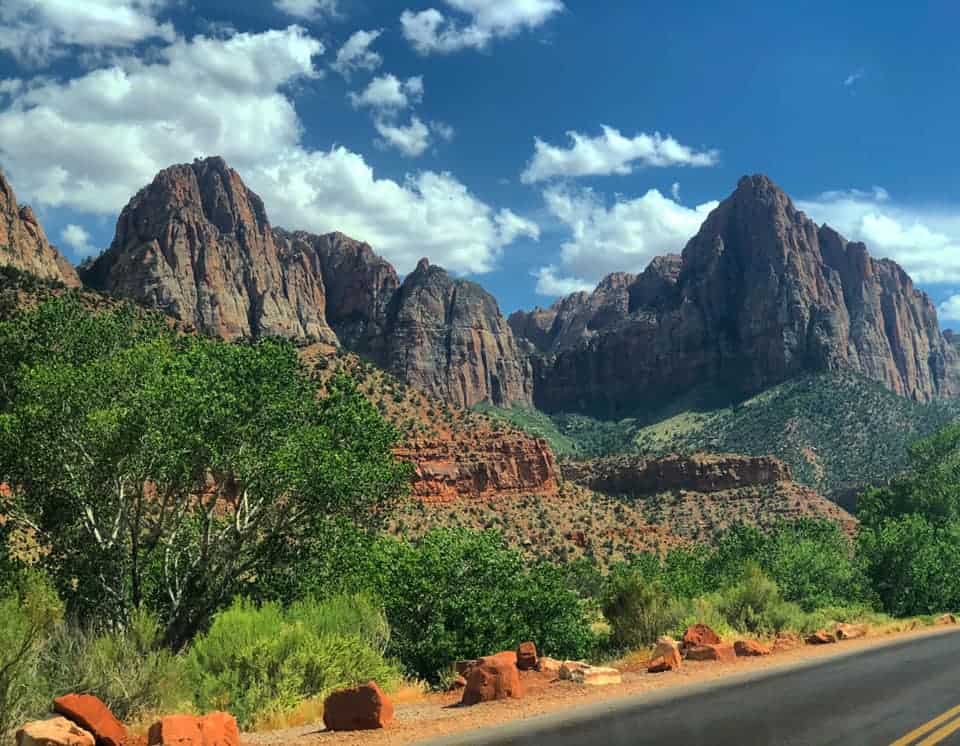
The most appealing aspect of visiting Zion in June is the abundance of activities available. Hiking, backpacking, rock climbing, canyoneering, bicycling, and off-roading are all options for visitors. In June, the temperature is hot, but there are gorgeous blue skies and great opportunities for sunrise and sunset photography.
By June, the temperature had climbed into the triple digits, where it will remain for the rest of the season. This is an ideal time to visit the park’s higher elevations, such as the Kolob Canyons and Kolob Terrace sections, as well as trek the Narrows, which is normally cooler than the rest of Zion Canyon. However, keep in mind that monsoon season begins in mid-July and lasts until mid-September, which means that a bright and sunny morning might quickly turn into a stormy afternoon with flash flood warnings.
The facility’s operational hours will be the longest of the year, thanks to ample daylight and adequate manpower. The park should be fully open and accessible, except for ongoing construction projects and unforeseen situations. To get to the Zion Canyon Scenic Drive and most of the treks in Zion Canyon, you’ll need to use the park shuttle bus. Summer is the busiest season in Zion National Park. Prepare to share the park with up to half a million other visitors each month.
Thank you for supporting this website written by an American. This post may contain affiliate links. This means I earn a small commission on these links at no extra cost to you.
National Park Entrance Fees
To enter the National Parks, you’ll need to pay an entrance fee or have a National Parks Pass also known as American the Beautiful Pass.
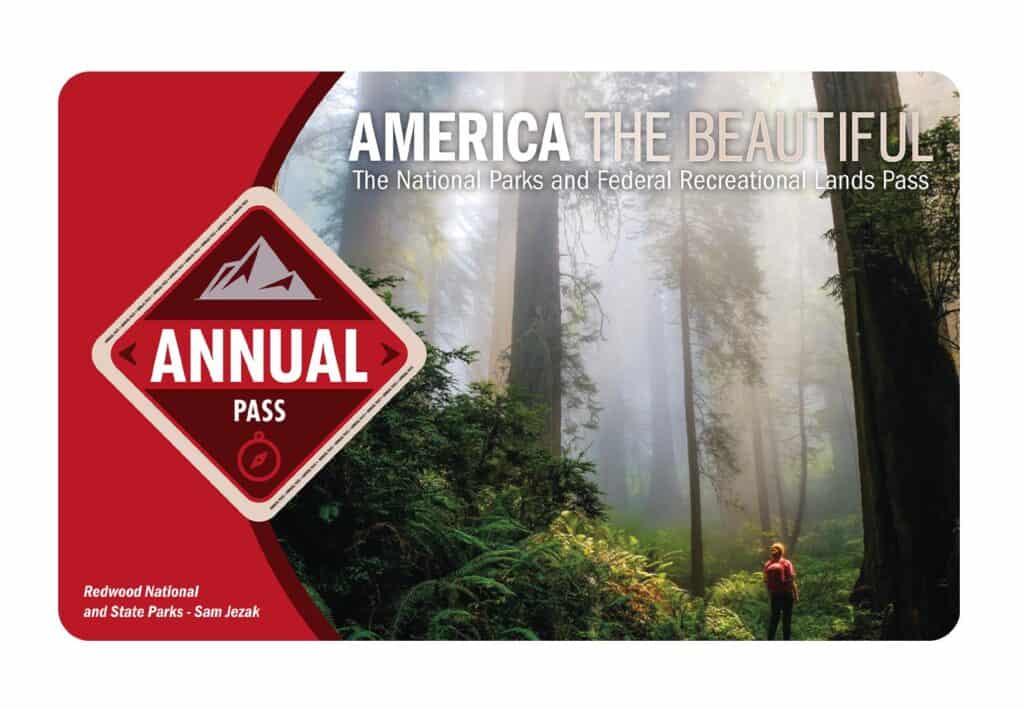
It costs $80 for a yearly America the Beautiful Pass. This gives you access to all national parks and federal areas that charge fees. The America the Beautiful Pass is well worth it!
I purchased my first one in 2016 and it’s such a money-saver! Plus 10% of sale proceeds go to the National Park Foundation.
Tips for Visiting Grand Teton National Park
Grand Canyon National Park is perfect for outdoor enthusiasts. There is something for everyone on this list and for different fitness levels. Also, note that it is dry and hot (in the summer), and make sure you know what you are getting into before you start. Here are a few tips for visiting the Grand Canyon:
- Bring a reusable water bottle and lots of water! Remember you are in the sun and you will need to drink lots of water. I love my LifeStraw Filtered Water Bottle. I can refill this bottle anywhere and it comes with a carabiner to connect it to my daypack.
- Check the Weather – days over 100 degrees are very common. Make sure to check.
- Hiking boots or sandals that will protect your feet! I love good shoes. I need all the support and help I can get. I actually love these sandals for hiking and also love these hiking boots.
- Bring hiking poles for balance and to protect your knees. I know many experienced hikers (and even amateur ones) think that hiking poles are for old people who lose their balance. Actually, hiking poles can help when going down steep inclines or when scrambling over rocks. They are great to hike with even for the most experienced hiker.
- Wear a sunhat. I feel like this whole post is about how high you are in the mountains and how much closer you are to the sun but it is so true. At elevation, you are closer to the sun and more likely to burn. Wear sun protection such as a sun hat and sunscreen.
- Be aware of the wildlife. This is the Southwest and you will need to watch out for snakes and other wildlife such as moose or a bear. Please stay away from wildlife and do not feed them. I recommend carrying bear spray as well.
- Start Early – If you want to avoid the traffic and the heat you will need to start your hike early. That way it will be nice and cool and the smog will not affect you either.
- Leave no trace. If you are new to the concept of Leave No Trace it is all about preserving the environment to ensure it is in the same or better condition when you leave it. This means that you should stick to the trails and carry out everything that you carried in. This is a great explanation of the Leave No Trace principles!
- Water shoes are great for water hikes– If you don’t have a pair, I highly suggest it as they are affordable. I have an article on the pros and cons of several pairs of water shoes.
- Bring Bug Spray and a snack: Be sure to bring everything you need including a snack like a protein bar plus BUG SPRAY.
Where to stay near Grand Canyon National Park
The Grand Canyon makes for a great weekend escape. Fresh air, beautiful scenery and being in nature does a world of good for the soul. I recommend staying as close to the park as possible and even treating yourself with a cabin with a spa pool to relax at night.
- There are lots of fantastic Airbnbs near the Grand Canyon. I have made a list of the best airbnbs around the park wherever you decide to stay. You can also check out my post on Where to Stay near the Grand Canyon to find the perfect hotel for any budget.
If you are taking a road trip remember to reserve a car in advance using Discover Cars .
National Park Entrance Fees
To enter the National Parks, you’ll need to pay an entrance fee or have a National Parks Pass also known as American the Beautiful Pass.

It costs $80 for a yearly America the Beautiful Pass. This gives you access to all national parks and federal areas that charge fees. The America the Beautiful Pass is well worth it!
I purchased my first one in 2016 and it’s such a money-saver! Plus 10% of sale proceeds go to the National Park Foundation.
Tips for Visiting Grand Teton National Park
Grand Canyon National Park is perfect for outdoor enthusiasts. There is something for everyone on this list and for different fitness levels. Also, note that it is dry and hot (in the summer), and make sure you know what you are getting into before you start. Here are a few tips for visiting the Grand Canyon:
- Bring a reusable water bottle and lots of water! Remember you are in the sun and you will need to drink lots of water. I love my LifeStraw Filtered Water Bottle. I can refill this bottle anywhere and it comes with a carabiner to connect it to my daypack.
- Check the Weather – days over 100 degrees are very common. Make sure to check.
- Hiking boots or sandals that will protect your feet! I love good shoes. I need all the support and help I can get. I actually love these sandals for hiking and also love these hiking boots.
- Bring hiking poles for balance and to protect your knees. I know many experienced hikers (and even amateur ones) think that hiking poles are for old people who lose their balance. Actually, hiking poles can help when going down steep inclines or when scrambling over rocks. They are great to hike with even for the most experienced hiker.
- Wear a sunhat. I feel like this whole post is about how high you are in the mountains and how much closer you are to the sun but it is so true. At elevation, you are closer to the sun and more likely to burn. Wear sun protection such as a sun hat and sunscreen.
- Be aware of the wildlife. This is the Southwest and you will need to watch out for snakes and other wildlife such as moose or a bear. Please stay away from wildlife and do not feed them. I recommend carrying bear spray as well.
- Start Early – If you want to avoid the traffic and the heat you will need to start your hike early. That way it will be nice and cool and the smog will not affect you either.
- Leave no trace. If you are new to the concept of Leave No Trace it is all about preserving the environment to ensure it is in the same or better condition when you leave it. This means that you should stick to the trails and carry out everything that you carried in. This is a great explanation of the Leave No Trace principles!
- Water shoes are great for water hikes– If you don’t have a pair, I highly suggest it as they are affordable. I have an article on the pros and cons of several pairs of water shoes.
- Bring Bug Spray and a snack: Be sure to bring everything you need including a snack like a protein bar plus BUG SPRAY.
Where to stay near Grand Canyon National Park
The Grand Canyon makes for a great weekend escape. Fresh air, beautiful scenery and being in nature does a world of good for the soul. I recommend staying as close to the park as possible and even treating yourself with a cabin with a spa pool to relax at night.
- There are lots of fantastic Airbnbs near the Grand Canyon. I have made a list of the best airbnbs around the park wherever you decide to stay. You can also check out my post on Where to Stay near the Grand Canyon to find the perfect hotel for any budget.
If you are taking a road trip remember to reserve a car in advance using Discover Cars .
Tips for Visiting in Zion National Park
Zion is perfect for outdoor enthusiasts. There is something for everyone on this list and for different fitness levels. Also, note that it is dry and hot (in the summer), and make sure you know what you are getting into before you start. Here are a few tips for visiting Zion:
- Bring a reusable water bottle and lots of water! Remember you are in the sun and you will need to drink lots of water. I love my LifeStraw Filtered Water Bottle. I can refill this bottle anywhere and it comes with a carabiner to connect it to my daypack.
- Check the Weather – days over 100 degrees are very common. Make sure to check.
- Hiking boots or sandals that will protect your feet! I love good shoes. I need all the support and help I can get. I actually love these sandals for hiking and also love these hiking boots.
- Bring hiking poles for balance and to protect your knees. I know many experienced hikers (and even amateur ones) think that hiking poles are for old people who lose their balance. Actually, hiking poles can help when going down steep inclines or when scrambling over rocks. They are great to hike with even for the most experienced hiker.
- Wear a sunhat. I feel like this whole post is about how high you are in the mountains and how much closer you are to the sun but it is so true. At elevation, you are closer to the sun and more likely to burn. Wear sun protection such as a sun hat and sunscreen.
- Be aware of the wildlife. This is the Southwest and you will need to watch out for snakes and other wildlife such as moose or a bear. Please stay away from wildlife and do not feed them. I recommend carrying bear spray as well.
- Start Early – If you want to avoid the traffic and the heat you will need to start your hike early. That way it will be nice and cool and the smog will not affect you either.
- Leave no trace. If you are new to the concept of Leave No Trace it is all about preserving the environment to ensure it is in the same or better condition when you leave it. This means that you should stick to the trails and carry out everything that you carried in. This is a great explanation of the Leave No Trace principles!
- Water shoes are great for water hikes– If you don’t have a pair, I highly suggest it as they are affordable. I have an article on the pros and cons of several pairs of water shoes.
- Bring Bug Spray and a snack: Be sure to bring everything you need including a snack like a protein bar plus BUG SPRAY.
Where to stay near Zion National Park
The Zion makes for a great weekend escape. Fresh air, beautiful scenery and being in nature does a world of good for the soul. I recommend staying as close to the park as possible and even treating yourself with a cabin with a spa pool to relax at night.
- There are lots of fantastic Airbnbs near Zion. I have made a list of the best airbnbs around the park wherever you decide to stay. You can also check out my post on Where to Stay near Zion
If you are taking a road trip remember to reserve a car in advance using Discover Cars .
Best Things to do in Zion in June
Angel’s Landing
Angels Landing is one of the most beautiful day hikes in the world, located in Zion National Park. The trail to its lofty top was carved out of the mountain’s steep, rock-solid spine in 1926, and hikers continue to be enthralled by it to this day.
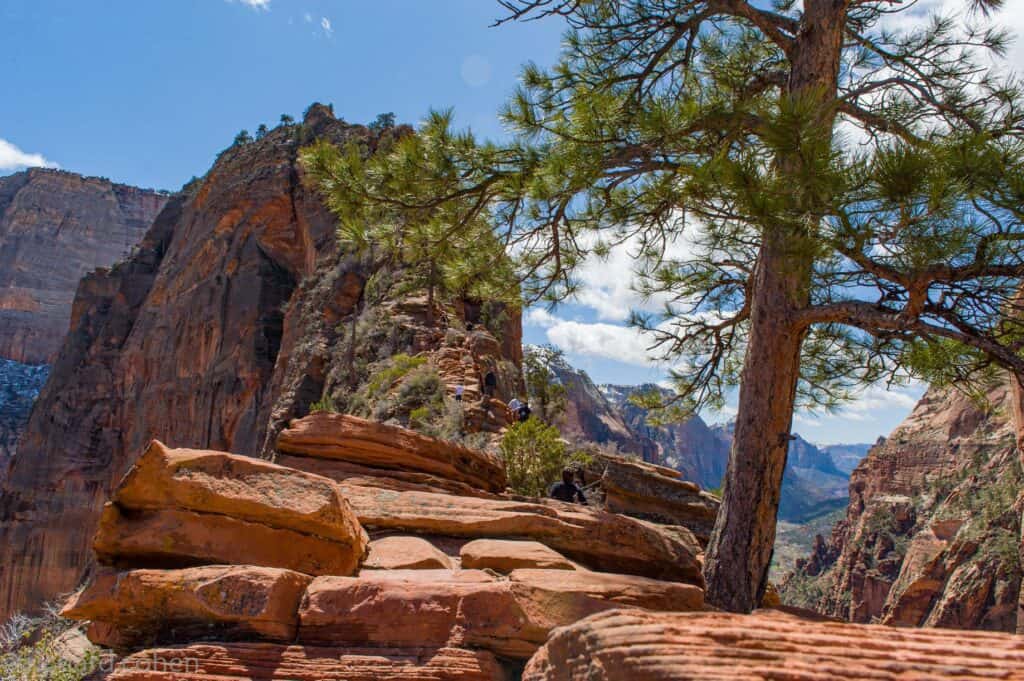
The trail rises approximately 1,500 vertical feet up a narrow ridge of stone to a maximum elevation of 5,790 feet. The peak is guarded by a chain fence, but if exposed heights make you weak in the knees, it will require a double dose of fortitude to reach the top. This is one adventure that crams a mountain of thrills into a short, strenuous hike.
You’ll reach the final viewpoint after a considerable amount of hiking and scrambling, and the effort will be well worth it; the view is truly breathtaking! Although Angels Landing is far lower in elevation than the rims, it provides an incredible 360-degree vista that exceeds any other.
When it comes to photographing Angels Landing, many people wonder when the best time is. That’s a tough question to answer because it depends on personal preference, but early morning and late afternoon will provide you with the most fascinating light but be sure to get off the mountain before nightfall.
You’ll be rock climbing to get to the top at its highest points, with a steep drop-off on either side. The trek and views are breathtaking, but all safety precautions must be done. The risk is real so make sure you have the right gear.
Kolob Terrace
Kolob Terrace is a distant part of Zion that may be reached through the Kolob Terrace Road. From South Virgin to Lava Point, the route leads to the park’s central area. This region of the park is less explored but offers stunning, breathtaking, scenic views. Many trailheads access the backcountry of Zion National Park from this section of the park.
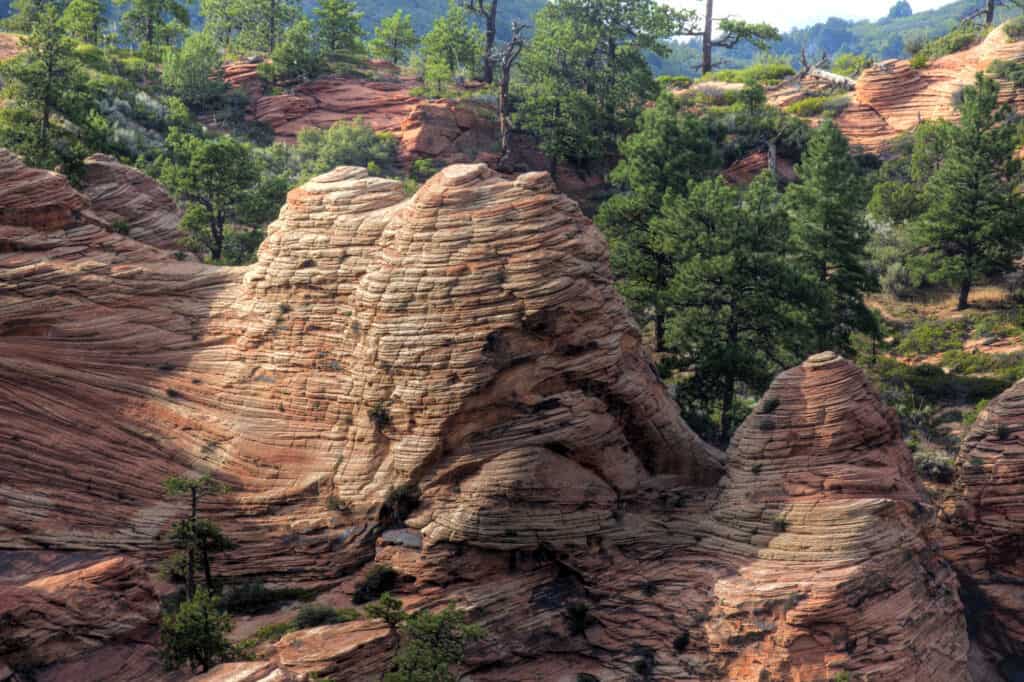
The Left Fork of the North Creek area of the Kolob Terrace, commonly known as “The Subways,” is a famous attraction. When hiking in any sector of the park, especially this one, hikers should adhere to the park’s rules and regulations.
These aren’t hikes that you can do in a loop. Out and back routes may have roundtrip distances given, or one-way distances may be listed. Hikers are not required to complete the entire experience; they can turn around at any point and return the same way they came. A wilderness permit is required for overnight trips.
Kolob Terrace is an excellent choice for anyone seeking a unique perspective on Zion National Park away from the crowds and development. Visitors appreciate Kolob Terrace’s unique vibe, which is characterized by a wild, free, and clandestine nature.
Water filling stations are not available at any of these trailheads. Fill your water before you arrive.
Kolob Canyons
The Kolob Canyons District of Zion National Park is located at Exit 40 on Interstate 15, 40 miles north of Zion Canyon and 17 miles south of Cedar City. Visitors may explore the red canyons and access different trails and gorgeous overlooks along the Kolob Canyons Road, which is a five-mile scenic drive.
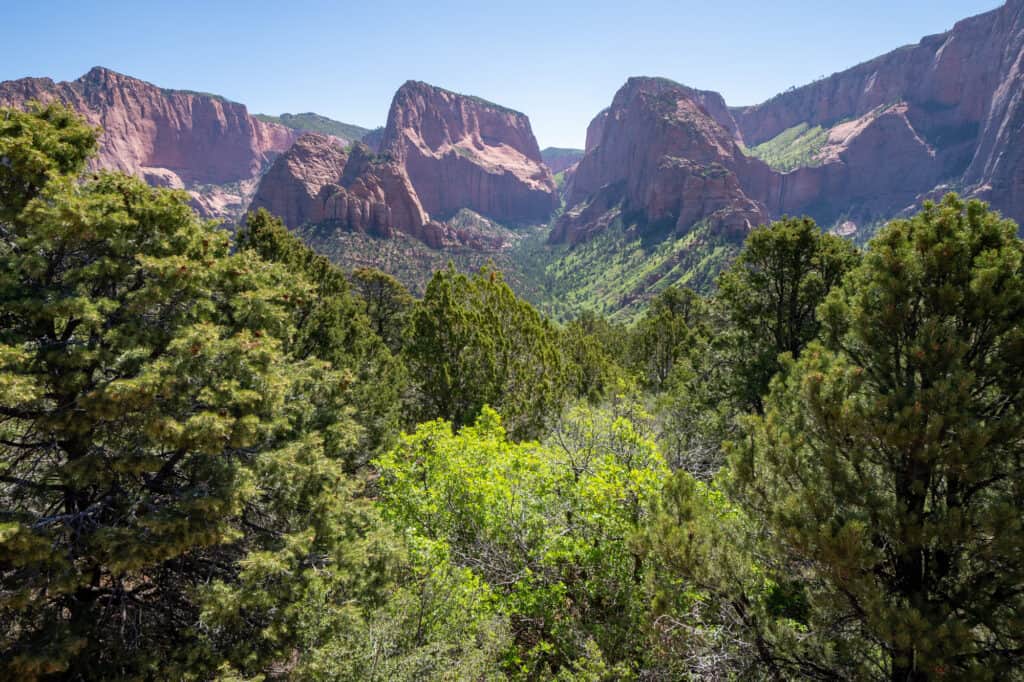
The canyons of Kolob have been declared as Wilderness, and their pure and primitive habitats are preserved. Hiking in the Kolob Canyons provides visitors with peace and tranquility in a beautiful desert landscape. Please be informed that linked groups of more than 12 people are only permitted to hike on the Timber Creek Overlook Trail to preserve the wilderness character and natural conditions of the area.
The Kolob Canyons in Zion National Park is extremely unique. New experiences and magnificent landscapes greet you around every corner, with soaring Navajo sandstone peaks, canyon streams and cascading falls, and over 20 miles of hiking trails.
Aside from hiking, the Kolob area offers intrepid canyoneers aquatic adventure in deep slot canyons. One challenging circular hike, generally done as an overnight trip, takes you up Willis Creek and into the beautiful Bear Trap Canyon, culminating in a rappel over a silvery waterfall. This hike will require a permit.
Kanarraville Falls, located north of the park, is an easy canyoneering hike up a slot canyon trail. This stunning location, which features waterfalls and coral-colored sandstone walls, necessitates wading up a raging creek and scaling ladders past the falls. The most popular hike starts at a trailhead on Kanarraville’s east side. To avoid crowds, visit on weekdays.
Canyon Overlook Trail
If you have a car, go Route 9 east to the iconic Zion Mt. Carmel Tunnel and enjoy the trip through the Upper East Canyon’s amazing Slickrock. The Canyon Overlook Trail, which begins just east of the tunnel and ends at a great viewpoint looking into the main canyon, is one of the few official trails in the upper East Canyon.
It is a nice short-but-sweet hike on a maintained trail that starts just east of the tunnel and ends at a great viewpoint looking into the main canyon. You’ll get some wonderful views down into the Pine Creek slot canyon below as well as a little respite in a cool shaded alcove with thick ferns sprouting out of the rocks. This hike is a must-do if you’re visiting Zion for the first time.
While many sections of the trail have rails, children and those who aren’t steady on their feet should be cautious because there are a few open locations where a fall could be dangerous. Halfway to the viewpoint, the walk enters a lovely tiny shaded alcove with a seep and luxuriant ferns growing out of the sandstone walls; this spot offers welcome relief during the summer months.
If the parking lot is full, continue down the road and park in one of the overflow parking lots or on the shoulders. While driving up the mountain, pull over to the last bend of the switchbacks to see the Great Arch of Zion. It’s a great spot for a photo, and you can see people on top of it if you look attentively. The Canyon Overlook Trail overlook is located there.
Arrive early because the small parking lot just outside the tunnel soon fills up. A fantastic night hike to see a spectacular show of stars or a spectacular sunset (make sure to bring a flashlight or headlamp).
East Rim Trails
The East Rim Trail is an excellent option for a long day hike or a leisurely backpacking trip. Hikers can either start at the Observation Point trailhead and ascend nearly 2000 feet to the plateau’s top or start at the east gate to Zion National Park and descend into the canyon. In any case, you’ll be treated to stunning views of Zion Canyon and Echo Canyon’s otherworldly coliseum. If you choose for the hiking trail, be sure to check the Deertrap and Cable Mountains spur routes for some rarely seen canyon-edge vistas. A wilderness permit is required for any overnight trips in Zion National Park, which can be purchased from the Zion Wilderness Desk.
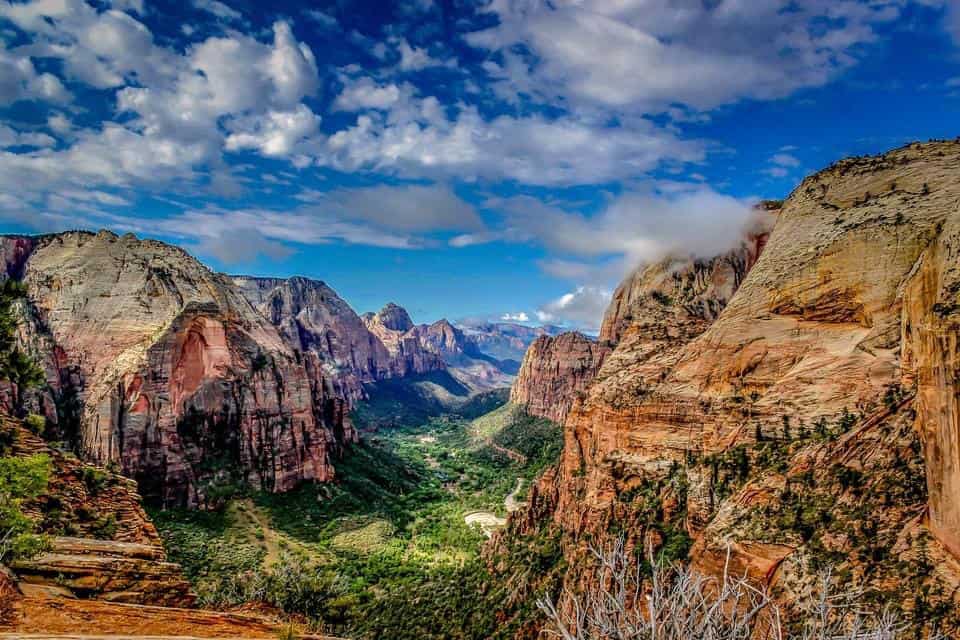
Beyond the gulch, the trail levels out and proceeds northwest through a scant ponderosa pine forest on a high mesa. Water flows intermittently from a pipe at Stave Spring, the halfway point. A trail junction can be found just past the spring. A left turn leads west to two spur trails that go to Deertrap and Cable mountain viewpoints above Zion Canyon. The East Rim Trail continues straight to the southern edge of Echo Canyon, passing another junction.
The East Entrance Trailhead has a lower elevation increase to the mesa top and is all downhill in the last stretch. Arrange for a shuttle to drop you off at the trailhead through a Springdale guide service, and then take the free Zion shuttle back to the visitor center.
Start your hike at Stave Trailhead at Zion Ponderosa Ranch Resort, which provides daily shuttle service to the trailhead and is a nice place to eat and browse the gift store before or after your hike.
La Verkin Creek
The trail begins at Lee Pass and travels along Timber Creek, passing past the open narrow canyons of the adjacent cliffs. The trail lowers the slope down to the creek bottom on a hard-packed track after coming around the corner and within view of La Verkin Creek. The trail heads upstream from the creek, providing spectacular views of the surrounding cliffs. From Lee Pass to Kolob Arch, one of the route’s main targets and one of the country’s largest free-standing arches, the trail is 7 kilometers long. To extend your trip or offer day hiking possibilities, continue up the canyon to Bear Trap Canyon and Willis Canyon.

The most popular usage of the trail is an in-and-out hike to see the Kolob Arch, which is both challenging and rewarding. Longer visits to Willis Creek and the Kolob Section’s lonely northeast portion are also possible because of the trail’s numerous campsites. The La Verkin Creek Trail is also part of the famous Trans-Zion Trek, which runs from the Kolob Canyons to the East Entrance of the park.
This is an excellent place to stay for a few days. The ideal times to hike this trail are in the spring, summer, and fall. In the winter, the trail is usually covered in snow, which might last until early spring. Camping is only permitted in specific areas.
Wildcat Canyon
The Wildcat Canyon Trail connects the Wildcat Canyon Trailhead with the West Rim Trail and is part of the Trans-Zion Trek, which permits trekkers to hike from the Kolob section all the way down to the main canyon. The Northgate Peaks Trail, the Left Fork of North Creek (the Subway), and the Right Fork of North Creek are all accessible from the Wildcat Canyon Trail. Although not a “destination walk,” this trail passes through some breathtaking landscapes.
As it weaves through the ponderosa pine forest, this trail begins at Wildcat Trailhead and continues past the Northgate Peaks Trail junction, providing views of the Northgate Peaks. It opens up into meadows before reaching the rim of Wildcat Canyon, where it offers sweeping views down into the canyon’s depths.
The trail descends gradually before looping around and crossing Wildcat Canyon’s dry streambed. A small unnamed spring about a quarter-mile west of the junction provides convenient access to water directly along the trail. Look up to view the stark lava rock formations and the distant Lava Point. The route turns around after passing over the streambed crossover and begins its final ascent to meet up with the West Rim Trail. You have the option to turn around or continue on your adventure!
The trail climbs slightly after crossing the canyon until it meets up with the West Rim Trail. Although there are no permanent campsites in this area, overnight trips do require a permit.
Hop Valley
The Hop Valley Trail connects the Hop Valley Trailhead (in the Kolob Terrace area of the park) to the La Verkin Creek Trail (in the Kolob Canyons section) and is part of the “Trans-Zion Hike,” which allows hikers to hike from the Kolob section all the way down to the main canyon. While the scenery in Hop Valley is breathtaking, this section of the park is part of a private enclave where cattle are still allowed to graze freely.
The trail starts near Kolob Terrace Road and winds its way across open fields with panoramic views of the surrounding rock formations. As you get closer to Hop Valley, the trail begins to descend. Hop Valley’s valley floor is stunning, with its flat sandy bottom and steep walls on all sides. The trail is sand-covered and well-worn. Before the steep slope into La Verkin Creek, the campsites are at the far end of the valley. Camping is only permitted in specific areas.
Thankfully, the two approved campsites in Hop Valley are north of the National Park Service fence that restricts livestock to the south. While the campsites are located on a bench above the streambed in a beautiful forested area, the sites are sandy and surrounded by many historic horse droppings. A campground along the nearby La Verkin Creek Trail would probably be the better option for anyone attempting the “Trans-Zion” Hike.
Lower Emerald Pools
Lower Emerald Pools is similar to Weeping Rock in that it has a weeping wall and pools at the base. A.6-mile round-trip paved trail leading from the Zion Lodge shuttle bus stop #5 leads to the site.
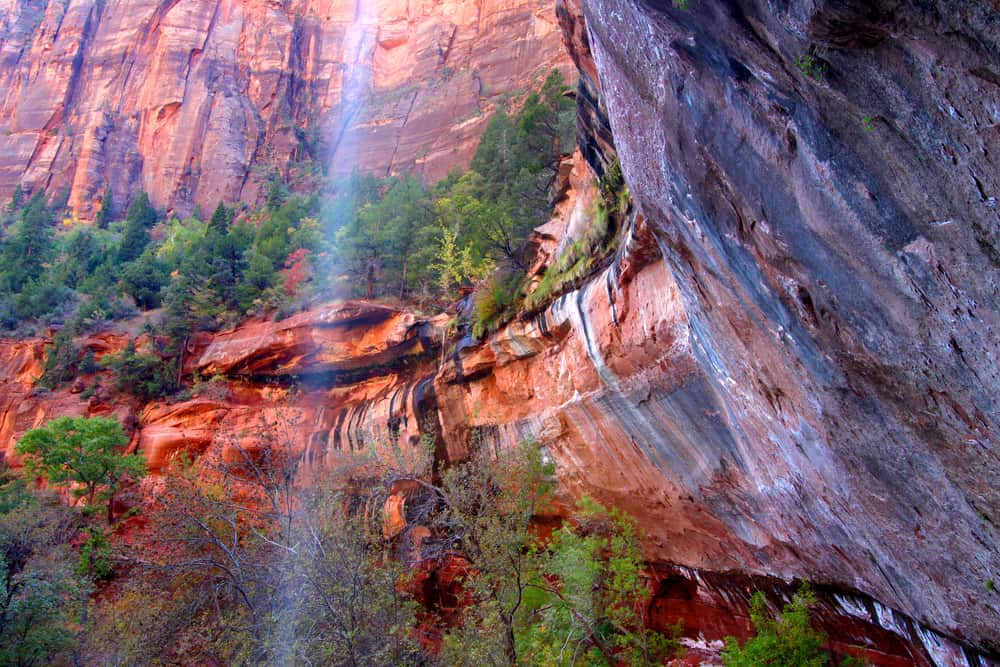
In the spring, when the leaves are out and the water is running over the wall, this is an especially lovely walk. If you have more time and energy, you can continue to preserve to the Middle and Upper Emerald Pools by trekking behind the falls.
In less than half a mile (1.5 mi), the foliage gets thicker, and the trail makes its way through a steep alcove beneath two tall waterfalls and the pools below. Even the elderly and parents using strollers will have no trouble getting to this location.
Observation Point
It’s difficult to beat Observation Point for panoramic views of Zion National Park. The hike is beautiful throughout, but it is arduous. It’s a steady ascent to the last viewpoint, which is 8 km long and 2300 feet in elevation. This is a typical Zion trail that is well worth the time and effort, especially if you want to see Angels Landing and the rest of the park.
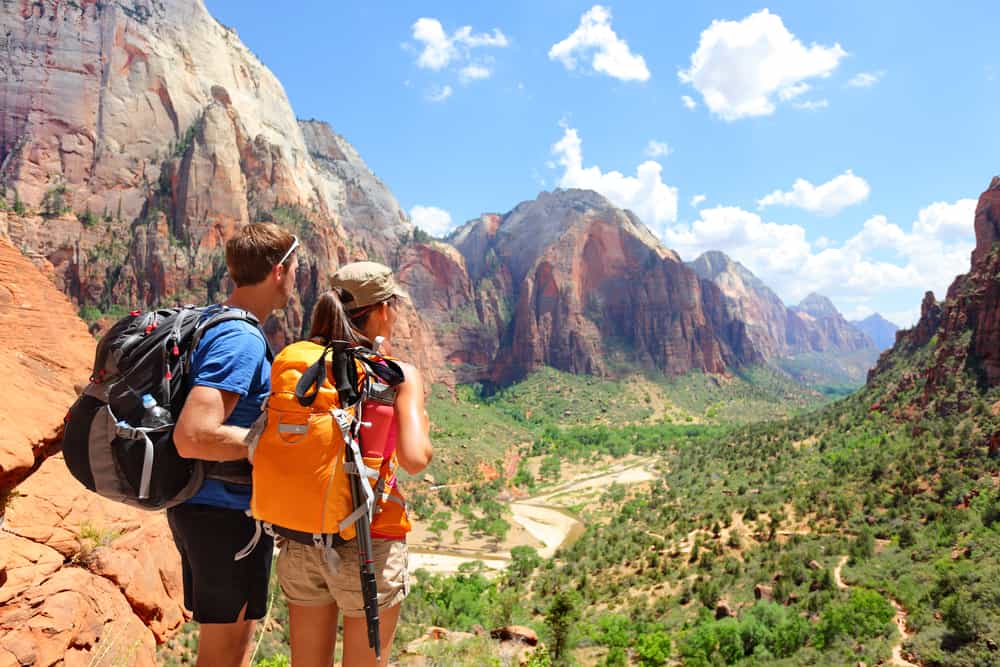
The most accessible of the rimrock views that border the canyon wall is Observation Point, which is positioned high above Zion Canyon. The trail starts by zigzagging up an amphitheater cut out of Zion Canyon’s wall by the river. A spur route climbs southward into the gap of Hidden Canyon about two-thirds of the way up the gradient.
Hikers can see the dark and mysterious Echo Canyon, with its spectacular dark slot canyon formations and stunning White Cliffs, along the way. While not as exposed or fear-inducing as Angels Landing, Observation Point is a more challenging trek. You’ll be nearly 700 feet above Angels Landing, looking down on it and the lovely main canyon from the final viewpoint.
Scenic Driving
From its western beginning at I-15 exit, 16 to its eastern junction with U.S. 89 at Mount Carmel Junction, the Zion Park National Scenic Byway follows Highway 9 from its western terminus at I-15 exit 16.
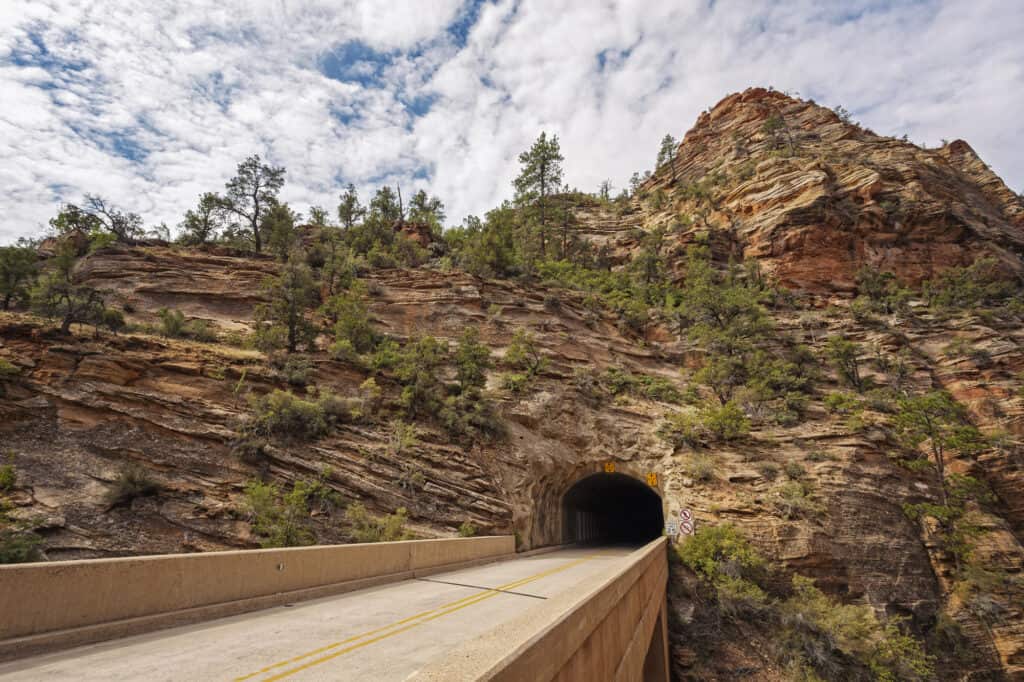
Completed in 1930, the road east from Zion to Mount Carmel Junction was regarded as one of the greatest road-building achievements in history at the time. You’ll see why it caused such a stir when you climb switchbacks from the canyon floor to the two high plateaus to the east, passing via two narrow tunnels blasted into the cliffs.
In the northern corner of Zion National Park, the Kolob Fingers Road Scenic Byway (5 miles one way) has the same dramatic desert terrain as the main section of the park: towering colorful cliffs, tight winding canyons, forested plateaus, and wooded trails down twisting side canyons. You won’t find many tourists here, so this is a nice area to visit if you’re looking for some serene.
To see the beauties of Zion National Park, you don’t have to go off the beaten path. The Zion Canyon National Scenic Drive is a scenic route that runs upstream from Canyon Junction along the North Fork of the Virgin River, passing through some of Zion’s most spectacular scenery. During the summer and fall, this road is blocked to private vehicles, but shuttle buses give a great option to relax and enjoy the view, or to stop for a hike and then catch a later bus back down the canyon.
You may still see the sights during the rest of the year, but you’ll have to do so from one of the park shuttles, which run daily from spring until late November.
The Pa’rus Trail
The Pa’rus Trail, named after the Paiute term for “bubbling water,” is one of Zion National Park’s newest and most accessible paths. It’s the only trail in Zion that allows bikes and pets, and it’s one of the park’s few wheelchair-accessible trails.
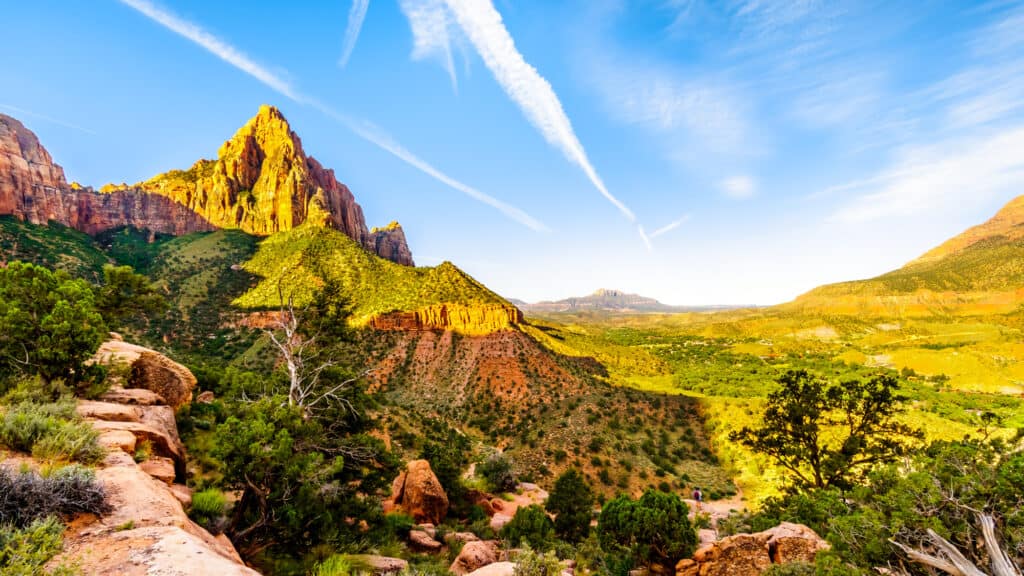
This wide, paved trail, which begins at the South Campground just north of the Visitor Center and finishes at the Canyon Junction, borders the Virgin River in the flat and open bottom area of Zion Canyon. The scenery is extremely pleasant throughout the trip, with multiple bridges crossing the river, various wildflowers, and mule deer frequently spotted.
The flat paved trail heads north along the west bank of the Virgin River, eventually leaving the campsite and putting you in a more remote area. There are several areas where you can walk down to the river, but please respect any “do not hike here” warnings.
Wildflowers bloom all along the trail, and mule deer can frequently be seen relaxing or grazing nearby. A historic diversion dam that was used to cut off water to Springdale is a notable monument. The route actually travels under Route 9 near its northern terminus, ending at the Canyon Junction shuttle stop.
The Canyon Junction bridge is also a famous place for sunset photographers.
Recent Posts
15 Tips for Visiting the Grand Canyon in September – 2023 Ultimate Guide
Visiting the Grand Canyon in September is a great time to visit. September is a busy time to visit but the crowds are starting to arrive especially toward the end of the month. I’ve included...
15 Tips for Visiting the Grand Canyon in August – 2023 Ultimate Guide
Visiting the Grand Canyon in August is a great time to visit. August is a busy time to visit but the crowds are starting to arrive especially toward the end of the month. I’ve included all...
